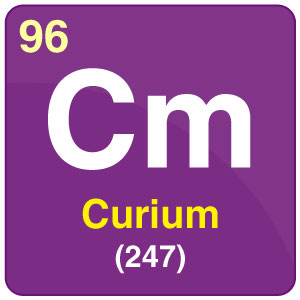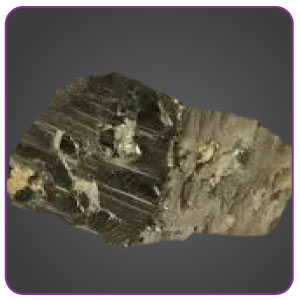Curium (Cm)

| Symbol | Cm |
| Atomic Number | 96 |
| Atomic Mass | (247) g.mol -1 |
| Discovered by | G.T. Seaborg in 1944 |

Chemical Properties of Curium
| Group | Actinides | Melting point | 1345°C, 2453°F, 1618 K |
| Period | 7 | Boiling point | Unknown |
| Block | f | Density (g cm−3) | 13.51 |
| Atomic number | 96 | Relative atomic mass | [247] |
| State at 20°C | Solid | Key isotopes | 243Cm, 248Cm |
| Electron configuration | [Rn] 5f76d17s2 | CAS number | 7440-51-9 |
| ChemSpider ID | 22415 | ChemSpider is a free chemical database | |
What is Curium ?
- Curium is a hard metal having an atomic number of 96 and symbol Cm. This metal is artificially produced in the nuclear reactors. It is electro-positive, radioactive and also a chemically active substance, which is not obtained naturally. This metal possesses some magnetic properties. As the temperature increases, the resistivity of this metal also increases.
- In the year 1944, Glenn Seaborg, Albert Ghiorso, and James discovered this metal and were named after Marie Curie and Pierre Curie.
Applications of Curium
- The isotopes of curium such as curium- 244 and curium 242 are used in power generation industries such as thermo-electric and thermionic converters.
- This metal is used in the X-ray spectrometer for the purpose of quantitative analysis
- In medical applications, it is used as power source.
- One gram of curium produces around 3 watts of thermal energy. For this reason, It is used in spacecraft applications.
- It has its wide uses in the field of research industries as it is a radioactive element.
Effects of Curium
- Curium is a hazardous metal, which causes some health disorders when inhaled.
- It damages the liver and also causes breathing and gastrointestinal problems when ingested.
- Rats, when injected with an isotope of curium, was observed to develop skeletal cancer.
- The radiation, which is emitted by curium are likely to cause the destruction of the red blood cells.
Environmental effects of Curium
- Improper disposal of curium leads to various environmental issues. Curium is found in nature in the form of its oxides.
- The radiation generated from this metal has many natural impacts.
- Curium is an insoluble chemical, which fixes the soil particles.
Frequently Asked Questions – FAQs
Q1
What is the atomic number of Curium?
The atomic number of Curium of 96.
Q2
What is the atomic mass of Curium?
The Atomic Mass of Curium is 247 g.mol −1.


Comments